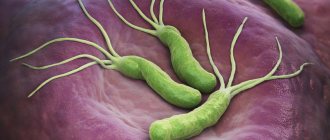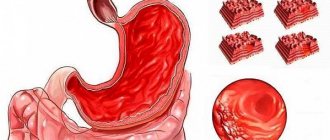Helicobacter bacterium: symptoms and causes
Abdominal pain, nausea, belching of air - all this may indicate that a dangerous, harmful Helicobacter bacterium has settled in the body, the treatment of which must be serious and thorough.
Helicobacter pylori is a very dangerous pathogenic microorganism that can lead to gastric and duodenal ulcers, gastritis and other diseases dangerous to the digestive system. Helicobacter was first discovered only 30 years ago. Medical research conducted since that time has proven that gastritis can have an infectious etiology. Also, according to studies of this bacterium, scientists have proven that, according to statistics, 75% of cases of stomach cancer in developed countries are caused by Helicobacter. In developing countries, this figure is even more frightening: 90% of patients with stomach cancer contracted the disease due to Helicobacter pylori.
Thus, it is worth pointing out the special role of early diagnosis of gastritis and gastric ulcers. It is a timely visit to a doctor that can save health and life.
Why do they refuse antibiotics when treating Helicobacter?
The presence of Helicobacter is not always a chronic infection.
The insensitivity of Helicobacter to antibiotics leads to a decrease in the effectiveness of treatment - a decrease in effectiveness was noted from 80-90% to 30-60%, which is typical for many countries and for various regions in Russia.
Today it is worth recalling once again the side effects of using antisecretory drugs and antibiotics.
Thus, when taking antisecretory drugs (PPIs), the processes of food digestion and absorption of calcium, iron, zinc, and medications when taken orally are disrupted. With long-term use of PPIs, there is a risk of developing infections of the gastrointestinal tract and lungs, since microorganisms from the oral cavity, nasopharynx, and intestines enter the stomach. If they are not inactivated under conditions of reduced gastric secretion, then some of them can produce substances (carcinogens) that can cause cancer. Long-term use of drugs that reduce gastric secretion can lead to
- diarrhea caused by the microorganism clostridium,
- fungal infection of the gastrointestinal tract,
- pneumonia,
- femoral neck fracture.
The use of antibiotics in the treatment of various diseases, including helicobacteriosis, is somewhat limited in the presence of liver diseases, kidney diseases, intestinal microflora disorders, and allergies to antibiotics
Treatment with antibiotics can lead to the development of antibiotic-associated diarrhea, deterioration of digestion, and cause dyseptic complaints - nausea, vomiting, changes in taste, and often headaches. This is especially true for older people. In addition, allergic reactions may develop, up to the formation of polyvalent allergies. These side effects, familiar to our patients, cause many to refuse to take antibiotics due to the risk of developing them.
Unfortunately, the official standards-IV of the Maastricht Agreement continue to recommend the use of these schemes, however...
What is the Helicobacter bacterium?
Helicobacter is a special type of pathogenic microorganism. It is a dangerous bacterium that infects the duodenum and stomach of humans. The microorganism itself is a parasite that produces toxic substances that damage the mucous membranes of organs. It is damage to the mucous membrane that leads to peptic ulcers, gastritis and other dangerous ailments.
It has long been believed that no organism is able to survive in the acidic environment of the stomach. But this does not apply to Helicobacter. The bacterium, on the contrary, thrives in an acidic environment, which is preferable for it to any other habitat. Helicobacter pylori has a spiral shape and flagella. This structure of the microorganism allows it to move through the mucous membranes of internal organs and cause irreparable harm to their integrity.
Helicobacter can adapt to almost any habitat. This is explained by the fact that this organism practically does not require oxygen. And another distinctive feature of Helicobacter pylori is its ability to change its own shape and become oval or round.
Russian scientists have come to the decision to introduce a special term - helicobacteriosis. It denotes all the processes that begin to occur in the body immediately after the introduction of this pathogenic microorganism into it. But Western scientists conducted studies of patients’ charts and came to the conclusion that about 60-65% of the population of the entire Earth are susceptible to infection. Thus, Helicobacter is the most common infectious disease of humanity after herpes, which is a viral disease.
Eradication therapy
Despite the use of combination treatment regimens, 10–20% of patients infected with H. pylori fail to achieve elimination of the pathogen. The best strategy is to select the most effective treatment regimen, but the possibility of using two or even more sequential regimens should not be ruled out if the treatment of choice is insufficiently effective.
If the first attempt at eradication of H. pylori fails, it is recommended to immediately proceed to second-line therapy. Antibiotic sensitivity testing and switching to salvage therapy regimens are indicated only for those patients in whom second-line therapy will also not lead to eradication of the pathogen.
One of the most effective “rescue regimens” is a combination of PPI, rifabutin and amoxicillin (or levofloxacin 500 mg) for 7 days. An Italian study led by Fabrizio Perri and published in Alimentary Pharmacology & Therapeutics in 2000 confirmed that the rifabutin regimen was effective against strains of H. pylori resistant to clarithromycin or metronidazole. However, the high price of rifabutin limits its widespread use.
NB! To avoid the development of resistance to both metronidazole and clarithromycin, these drugs are never combined in the same regimen. The effectiveness of such a combination is very high, but patients who do not respond to therapy usually develop resistance to both drugs at once (a study by German scientists led by Ulrich Peitz, published in Alimentary Pharmacology & Therapeutics in 2002). And further selection of therapy causes serious difficulties.
Research data confirm that a 10-day salvage therapy regimen, including rabeprazole, amoxicillin and levofloxacin, is much more effective than standard second-line eradication therapy (a study by Italian scientists led by Enrico C Nista, published in Alimentary Pharmacology & Therapeutics in 2003 year).
What happens in the body
As soon as Helicobacter enters the human body, it immediately descends into the stomach, where it lives for the rest of the time. In order not to die from gastric juice, the composition of which is quite aggressive, Helicobacter secretes special enzymes that surround it with a shell and neutralize the acid. The spiral-shaped antennae that Helicobacter has allow it to drill through the mucous layer and get to the cells of the parietal tissues, which are usually hidden from acid.
It is the parietal cells of tissues that become the main food for Helicobacter. The pathogenic microorganism eats them and poisons the environment with the products of its vital activity. At the same time, those blood cells that react to Helicobacter and strive to destroy them (neutrophils) wake up in the body. However, by destroying the pathogenic microorganism, neutrophils also destroy mucosal cells that have already been touched by Helicobacter.
After the layer of the mucous membrane is damaged, hydrochloric acid begins to actively affect the tissue. This is how the inflammatory process develops and an ulcer occurs. The localization of ulcers is most often similar. This is explained by the fact that Helicobacter itself is very fond of two parts of the stomach - the bulb and the pylorus.
Bismuth preparations
Bismuth was one of the first drugs to eradicate H. pylori. There is evidence that bismuth has a direct bactericidal effect, although its minimum inhibitory concentration (MIC - the smallest amount of drug that inhibits the growth of a pathogen) against H. pylori is too high. Like other heavy metals such as zinc and nickel, bismuth compounds reduce the activity of the enzyme urease, which is involved in the life cycle of H. pylori. In addition, bismuth preparations have local antimicrobial activity, acting directly on the bacterial cell wall and disrupting its integrity.
Causes of Helicobacter pylori infection
Helicobacter bacteria cannot exist in air; with active air intake, these pathogenic organisms die. They are transmitted mainly through human mucus and saliva. Thus, most often infection occurs in the following ways:
- Sharing utensils;
- Using only personal hygiene products;
- Kisses;
- From mother to child.
Thus, friends, family and cohabitants of the patient may be at risk.
In general, infection is facilitated by a low standard of living and neglect of hygiene rules. Very often, helicobacteriosis occurs in people living in communal apartments and dormitories, orphanages, as well as in medical workers. It is worth noting that in third world countries the disease occurs much more often than in developed countries. In Russia, in recent years, the incidence of gastritis and ulcers due to the influence of Helicobacter has begun to be noted among people from wealthy segments of the population.
You can protect yourself, and it is better to take care of prevention in advance than to suffer from an illness and look for ways to fight Helicobacter urgently.
Who is treated with probiotics?
Treatment of Helicobacter pylori infection using only probiotics is indicated:
- persons with a history of allergies to antibiotics,
- if the patient categorically refuses to take antibiotics,
- persons with diagnosed helicobacteriosis without clinical manifestations and complaints,
- family members of patients infected with Helicobacter,
- patients with chronic gastroduodenitis, peptic ulcer without exacerbation,
- To old people,
- children,
- persons with liver and kidney damage.
Further research has shown that not only probiotics based on living microorganisms, but also the products of their metabolism (metabolism) have a positive effect. Based on this discovery, a new drug with a unique anti-Helicobacter effect was developed in Russia in 2014.
Diagnostics
Diagnosis of Helicobacter pylori at the A-Media clinic is carried out using modern methods, among which are:
- 13C urease breath test for Helicobacter (the most accurate way to identify bacteria).
- A blood test for immune enzymes that determines antibodies to Helicobacter pylori.
- Polymerase chain reaction technique (saliva analysis).
- Gastroscopy (collection of material during FGDS).
Treatment
Usually, when a patient is diagnosed with Helicobacter, treatment is carried out with antibiotics. Our experienced doctor selects all medications individually for each patient, depending on the characteristics of his body.
The duration of the course of therapy is usually two weeks.
When treating Helicobacter pylori, the patient must completely stop drinking alcohol and, preferably, smoking. Also, a specialist from our clinic will help him adjust his diet.
In cases where the bacterium has already provoked any disease, our doctor will prescribe complex therapy aimed at treating the emerging pathology and eliminating Helicobacter pylori.







